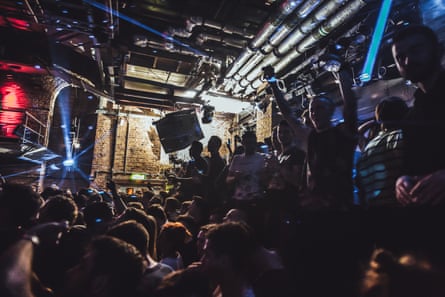If there’s one word that flashes, strobe-like, when London’s Fabric nightclub is mentioned, it is “resilience”. Despite the changing whims of dance music fans over the decades and a much-publicised closure in 2016, this year Fabric is celebrating a double decade of dancefloor dynamite. It has survived in a stifling climate for clubs where few others could.
Fabric opened in October 1999 in a former meat storage unit in Farringdon during house music’s first mainstream moment. Flashy superclub Home had opened in Leicester Square a month earlier, with Paul Oakenfold at the helm and a £70,000 marketing spend. But the 1,600-capacity Fabric was outside central London, had a non-commercial music policy and resident DJs – Terry Francis and Craig Richards – who were relatively unknown. Co-founders Keith Reilly and Cameron Leslie wanted to deliver not a superclub but a superb club: five-star hospitality with a side of old-school rave anarchy. “It was very much an antidote to the time, to big Radio 1 DJs,” says Leslie.
With the endless scroll of parties and festivals on offer today, it’s perhaps easy to forget the enormity of what Fabric has offered, week in, week out, besides managing to stay open. It made sound the star, installing crystalline custom-made systems and its fabled “bodysonic dancefloor” through which an estimated eight million clubbers have felt the bass rattle their ribcages. Even its design was innovative, turning flyers into an art form long before Instagram cranked up the appetite for visual stimulation.
When I was working on Time Out magazine’s nightlife desk from 2006 to 2012, Fabric was a rite of passage not just for clubbers but also, crucially, up-and-coming DJs. You’d not had a proper night out in the capital until you’d queued for their infamous unisex loos (groundbreaking at the time) and you weren’t a one-to-watch unless you’d played in room three’s hallowed booth. Many selectors got their break playing at Fabric just as they now get their shot spinning on a Boiler Room live stream. Berlin techno stalwart Ellen Allien knew that when she said last year: “If you make it to Fabric you can be sure you’re a good DJ.” The club gave “a platform to unsung heroes,” says Saturday programmer Judy Griffith, championing “the DJs that were in the back room.”

This approach meant that Fabric took risks on emergent strains of dance music they believed in, even if they weren’t yet popular, or if their popularity had waned. Grime, for example, was given a home before its mainstream resurgence via Skepta and Stormzy, by programming nights such as Butterz in room three. Fabric’s lineups and series of mixes document the evolution of electronic music, from minimal techno to dubstep and disco, and from drum’n’bass and breakbeat to all shades of house – deep, tech, ghetto, bassline and beyond. The club also championed LGBTQI culture, giving over its space to large-scale queer parties such as WetYourSelf! and Little Gay Brother on Sundays.
Fabric’s importance as a music institution came into sharper focus in 2016, when two drug-related deaths forced its closure. The subsequent campaign to overturn that decision raised £333,568, with over 160,000 signees on a petition to save the club. That snowballed into a wider #SaveOurCulture hashtag to raise awareness of the overall erosion of nightlife venues. Fabric settled its case before the appeal proceedings began and reopened in January 2017 under a set of 32 new licensing conditions. Sadiq Khan employed the city’s first Night Czar, Amy Lamé, to help embolden London club culture. But while the fight had been won and the fanfare died down, it’s far from over – now the battle is to make the business of clubbing work.
“We lost momentum,” says Leslie of the past two years. “It was one thing getting our licence back but it doesn’t mean that you reopen and you’re automatically the same venue you were before.” In the six months it was shut, clubland had already changed. There was new competition in the shape of giant daytime venues such as Printworks and Tobacco Dock, plus a plethora of festivals. DJs’ schedules were already busy. By the time they had reopened, many artists, said Terry Francis, were “all booked up … It really did throw a spanner in the works.”

The main issue is still, however, “having a big venue with the UK licensing laws as they are,” explains Leslie. Those laws are, he says, “deeply flawed. I’m not just talking about Fabric – I’m talking about any fixed club that has to be open 52 weeks a year to pay its bills.” With “huge business rates [and] the late-night levy taxes on venues like ours [which came into effect in November 2017]”, in order “to keep a high quality management staff that is able to operate a complex business within the licensing laws”, running a club is, he says, “completely different to how it was 10 years ago, or certainly 20 years ago when we started.
“Bizarrely, we’re under no different scrutiny than we were prior to closure,” he says, it’s just that running a club has “become more complex because the operating costs and the margins have got so squeezed.” As a result of overheads like these, he admits – as well as licensing restrictions that include a new over-19s policy, “you have to strike that balance between putting lineups on that you are confident are going to be able to pay the bills,” and “the ones you feel are important even if they aren’t obvious.”
The music that the club announced for their 20th birthday certainly felt, in one way, like a curveball: blokey Ibiza-famous tech-house mainstays such as Tale of Us and the Martinez Brothers, who arguably blunt the edge that Fabric is known for. The club also drew criticism for the stunt to launch its 20th birthday celebrations, for which they painted the front of the club black and deleted its social media account. It could easily have been interpreted as tasteless, considering there were fears it had been shut all over again, although Leslie says a statement was necessary, to “cut through the noise”.

Stunts aside, however, it would be naive to expect a club that is open all year to survive on acceptably cool lineups alone. “A lot of the underground nights that we were known for, they’re not so well-attended now,” Griffith says, adding that clubbers now “don’t want to take the risk” on unknown DJs. “We have to mix it up a lot more in order to survive. We want to still be here in 10 years’ time.”
Griffith says that the six Sunday nighters they’ve confirmed so far are only “phase one” of the birthday announcement, which they are planning to roll out in 2019. They’re also nurturing new DJs in their arsenal of residents, including Anna Wall and Bobby, to continue the spirit of, as Griffith puts it, “championing the underdog”.
To survive, the club will need future generations to be drawn to it every single weekend, beyond the occasional back-to-back set between Craig Richards and Ricardo Villalobos (a thing of nightlife legend). And while they don’t have a clear answer for how to do that, they do at least seem to be starting them off young. “I was in the other Sunday for an event called Big Fish Little Fish,” says Francis, “and there was all these people in there with kids on their shoulders, like a proper kids’ rave. It sold out in an hour!”
Five key Fabric tracks
Cpen: Pirate’s Life
Cameron Leslie: “It’s the track the epitomises the first year of Fabric. Craig Richards played it on the club’s first birthday and I remember being on the dancefloor and the whole of room one was just in this perfect state of happiness and celebration. The simplicity of what we’ve always tried to do from day one is put on the best events we can in the best possible environment and make it available to everybody rather a select elite.”
The Undertones: Teenage Kicks
Christian Williams, content manager: “This is taken from John Peel: FabricLive 07. It was a huge moment having him contribute to the mix series – it was the only mix he ever released, and he was someone whose taste we were all influenced by. Every artist on the series traditionally plays at the club to launch the album – we had to do a bit of convincing as he wasn’t much of a club DJ but eventually we got him to agree. As on Fabriclive 07, he closed with Teenage Kicks, the crowd started chanting his name, and carried him out of the room on their shoulders. It was as spectacular as it sounds.”
Ricardo Villalobos: Dexter
Christian Williams: “It’s almost impossible to pick one track that could sum up Ricardo’s history with us, but Dexter will always have a special room one feeling to it. It came out on Ricardo’s groundbreaking debut album Alcachofa in 2003, around a year after we’d first invited him to the club. European minimal wasn’t such a big thing in the UK at this point – Craig Richards had also started to introduce the sound in his sets, but it wasn’t something the London audience was used to. Ricardo came back to play a number of times over the next year, marking the start of his relationship with us. By the time Alcachofa was released some months later, the world had discovered a new electronic music star.”
Convextion: Premiata
Craig Richards, music director: “After 20 years it’s impossible for me to pick just one tune that represents the sound of Fabric. Closing room one is one of the most rewarding DJ experiences imaginable. The combination of vinyl, a warm rotary mixer, a killer sound system and an attentive audience allowed me freedom and confidence in my work. I chose this track because it truly represents the early morning sound of Fabric. I have never stopped playing it. It is a timeless piece of deep electro techno music, which still sounds like the future.”
Schatrax: Mispent Years
Anna Wall, Fabric resident: “I was too young to be raving when this came out, but it was the last track on Craig Richards’s Fabric 01 mix and it’s one I still play today. It’s these kinds of records that I imagine embodied what was going on in the club’s early years – that proper UK style of house and techno that was being pioneered by Craig and Terry – and it’s a sound that still influences me today. When I see DJs like Craig playing at Fabric pulling out old records – many I’ve never come across before – I feel like I’m constantly learning. Tunes from the 90s and early 2000s always come back around. I love that Fabric is constantly evolving, bringing in new artists and ideas, while still being a club where classic records remain commonplace.”

Comments (…)
Sign in or create your Guardian account to join the discussion